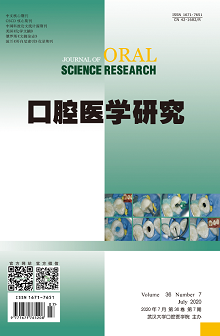|
|
Effects of D-valine Loaded Hydrogel on Rat Periodontitis
WANG Kunyu, SUN Yuyan, ZHANG Huiyan, QI Xiaoshuang, ZHANG Zhenyang, QIAO Shuwei, XIANG Jingcheng, DING Jiaxin, MENG Weiyan
2020, 36(7):
658-663.
DOI: 10.13701/j.cnki.kqyxyj.2020.07.012
Objective: To investigate the effect of D-valine hydrogel on experimental periodontitis and related inflammatory factors in rats. Methods: Thirty SD rats were divided into five groups: negative control group (group A), periodontitis model group (group B), the periodontitis with PaiLi (group C, positive control group), the periodontitis with D-valine hydrogel (group D), and the periodontitis with blank hydrogel (group E). The gingival index (GI), plaque index (PI), periodontal pocket depth (PD), and alveolar bone absorption (ABL) were measured by CBCT. Pathological changes of periodontal tissues were observed by HE staining, and the levels of IL-1β, IL-6, IL-10, and TNF-α were detected by ELISA. Results: The periodontal index, IL-1β, IL-6, and TNF-a in the model group were all increased and IL-10 was decreased. The GI, PI, and ABL in the group C and D were significantly lower than those in the group B (P<0.05), and the PD values in the groups C, D, and E were not significantly different from those in the group B (P>0.05). The IL-1 β, IL-6, and TNF-a levels in the group D were significantly lower than those in the group B (P<0.01), while the IL-6, TNF-a levels in the group D were not significantly different from those in the group A (P>0.05). And the level of IL-10 in group D was significantly higher than that of group B (P<0.01). Conclusion: D-valine hydrogel can reduce inflammatory factor level, reduce alveolar bone resorption, and improve periodontitis, which may be related to periodontal pathogens.
References |
Related Articles |
Metrics
|

